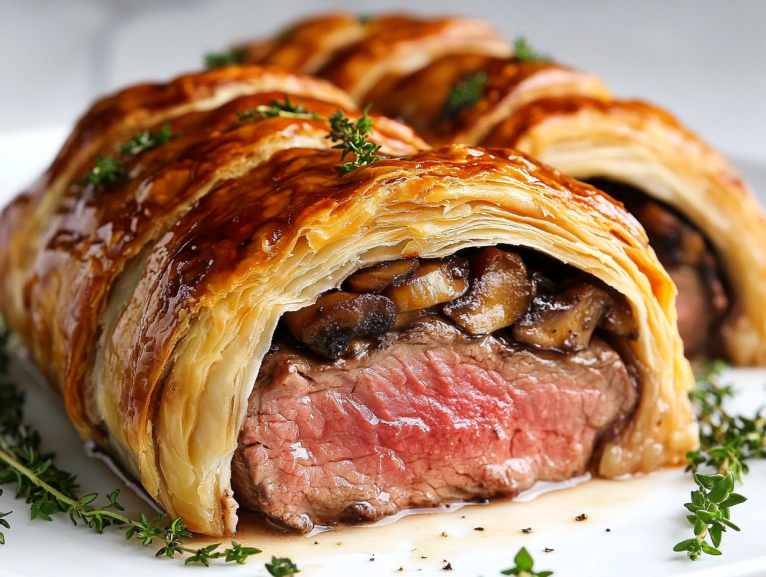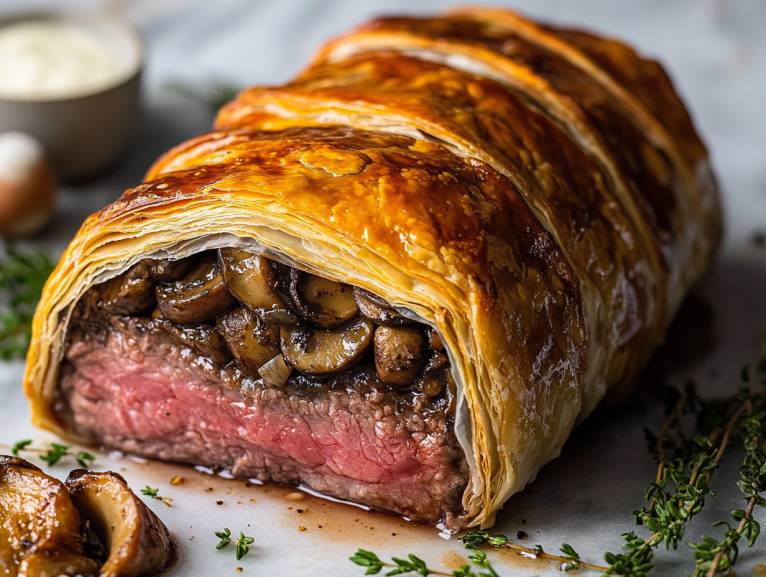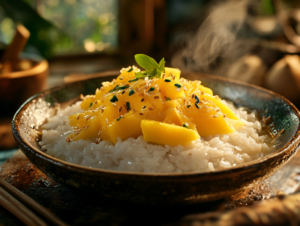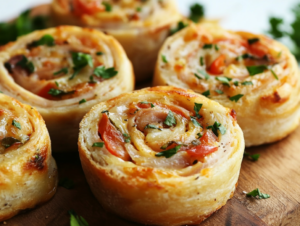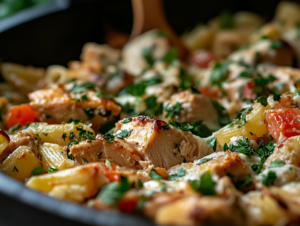Beef Wellington is a culinary masterpiece that combines tender beef tenderloin, savory mushroom duxelles, and delicate puff pastry into a harmonious and elegant dish. This classic recipe has graced dining tables for centuries, offering a luxurious experience that’s perfect for special occasions or when you want to impress your guests.
History of Beef Wellington:
The origins of Beef Wellington are debated, with some attributing it to Arthur Wellesley, the 1st Duke of Wellington, while others believe it is an adaptation of the French dish “filet de bœuf en croûte.” Regardless of its beginnings, it has become a beloved classic in British and international cuisine.
Variations:
- Individual Portions: Create single-serving Wellingtons for personalized presentation.
- Mushroom Substitutes: Use a mixture of wild mushrooms for a more complex flavor.
- Sauce Additions: Incorporate a layer of pâté or foie gras for added richness.
Ingredients:
- 1 center-cut beef tenderloin (approximately 2 pounds)
- Salt and freshly ground black pepper
- 2 tablespoons olive oil
- 2 tablespoons Dijon mustard
- 1 pound mushrooms (such as cremini or button), finely chopped
- 2 tablespoons unsalted butter
- 2 cloves garlic, minced
- 2 tablespoons fresh thyme leaves, chopped
- 8 thin slices of prosciutto
- 1 sheet puff pastry, thawed
- 1 egg, beaten
Instructions:
- Prepare the Beef:
- Season the beef tenderloin generously with salt and freshly ground black pepper.
- In a large skillet, heat the olive oil over high heat. Sear the beef on all sides until browned, about 2-3 minutes per side.
- Remove from heat and brush the tenderloin with Dijon mustard while it’s still warm. Set aside to cool.
- Make the Mushroom Duxelles:
- In the same skillet, melt the butter over medium heat. Add the finely chopped mushrooms, minced garlic, and chopped thyme leaves.
- Cook until the mixture becomes a thick paste and all moisture has evaporated, approximately 10-15 minutes. Season with salt and pepper to taste. Let it cool completely.
- Assemble the Wellington:
- Lay a large piece of plastic wrap on a flat surface. Arrange the prosciutto slices on the plastic wrap, slightly overlapping, to form a rectangle large enough to envelop the beef.
- Spread the cooled mushroom duxelles evenly over the prosciutto layer.
- Place the seared beef tenderloin at the edge of the prosciutto-mushroom layer. Using the plastic wrap, carefully roll the prosciutto and mushroom mixture around the beef, forming a tight log. Twist the ends of the plastic wrap to secure and refrigerate for 15-20 minutes to firm up.
- Wrap in Puff Pastry:
- Preheat your oven to 400°F (200°C).
- On a lightly floured surface, roll out the puff pastry sheet into a rectangle large enough to encase the beef.
- Remove the beef from the plastic wrap and place it in the center of the puff pastry. Brush the edges of the pastry with the beaten egg.
- Fold the pastry over the beef, sealing the edges to form a tight package. Trim any excess pastry to avoid a thick crust.
- Place the wrapped beef seam-side down on a baking sheet lined with parchment paper. Brush the entire surface with the remaining beaten egg.
- Using a sharp knife, score the top of the pastry with a decorative pattern, being careful not to cut through to the beef.
- Bake:
- Bake in the preheated oven for 25-30 minutes, or until the pastry is golden brown and the internal temperature of the beef reaches 125°F (52°C) for medium-rare.
- Remove from the oven and let it rest for 10 minutes before slicing.
Nutritional Information (per serving):
- Calories: Approximately 650
- Protein: 45g
- Fat: 40g
- Carbohydrates: 25g
- Fiber: 2g
- Sodium: 1200mg
Servings: 4
Prep Time: 30 minutes
Cooking Time: 45 minutes
Total time: 1 h 15 minutes
Tips for Success:
- Choose the Right Cut: Opt for a center-cut beef tenderloin for uniform cooking.
- Searing: Ensure a good sear on the beef to lock in juices and add flavor.
- Chilling: Chill the wrapped beef to maintain its shape during baking.
- Pastry Handling: Work quickly with the puff pastry to prevent it from becoming too warm and difficult to handle.
Serving Suggestions:
Pair your Beef Wellington with roasted vegetables, creamy mashed potatoes, or a fresh green salad. A rich red wine sauce or a classic Béarnaise sauce complements the dish beautifully.
Wine Pairing:
A full-bodied red wine, such as Cabernet Sauvignon or Merlot, enhances the flavors of the Beef Wellington.
Best Wine Pairings for Beef Wellington
Pairing the right wine with Beef Wellington enhances its rich, savory flavors. Since this dish features tender beef, umami-packed mushrooms, and buttery puff pastry, a full-bodied red wine is the best choice.
Top Wine Pairings:
- Cabernet Sauvignon – A classic choice with bold tannins that complement the beef’s richness.
- Pinot Noir – A lighter red with earthy notes that enhance the mushroom duxelles.
- Merlot – Smooth and fruity, balancing the dish’s buttery texture.
- Syrah/Shiraz – Peppery and robust, perfect for a well-seasoned Wellington.
- Bordeaux Blend – A structured wine with depth, pairing well with the layers of flavor.
For a white wine option, go for an oaky Chardonnay, which has enough body to stand up to the richness of the dish.
Pro Tip: Serve the wine slightly below room temperature (60–65°F / 15–18°C) to bring out its best flavors.
Common Mistakes to Avoid:
Making Beef Wellington is easier when you avoid these pitfalls:
- Overcooking the beef – Always use a thermometer to check doneness.
- Too much moisture in the duxelles – Cook the mushrooms thoroughly before assembling.
- Soggy bottom pastry – Chill the Wellington before baking to firm up the layers.
- Not resting the beef – Resting prevents juices from spilling out when slicing.
Choosing the Best Ingredients for Beef Wellington
To achieve the best results, selecting high-quality ingredients is crucial.
1. Beef Tenderloin
- Choose a center-cut tenderloin, about 2 pounds, evenly shaped for uniform cooking.
- The best quality comes from grass-fed or prime-grade beef for maximum tenderness.
2. Mushrooms
- Cremini, button, or wild mushrooms work well for the duxelles.
- Avoid excess moisture by cooking them thoroughly before assembling.
3. Prosciutto
- Thinly sliced prosciutto enhances the umami taste and helps keep the beef dry inside the pastry.
4. Puff Pastry
- Use all-butter puff pastry for the best flavor and texture.
- Ensure it stays cold before wrapping the beef to get a crispy, flaky crust.
5. Dijon Mustard
- Adds a layer of tangy sharpness that cuts through the richness of the beef and mushrooms.
How to Know When Beef Wellington is Done
Use a meat thermometer to ensure the perfect doneness:
- Rare: 120°F (49°C)
- Medium-Rare: 125°F (52°C) (recommended)
- Medium: 135°F (57°C)
- Well-Done: 150°F (65°C)
Keep in mind that the temperature will rise slightly after removing from the oven, so let it rest for 10 minutes before slicing.
How to Get the Perfect Puff Pastry Crust
Achieving a golden, crispy crust is one of the keys to a perfect Beef Wellington. Follow these tips:
- Use cold puff pastry to prevent butter from melting.
- Score the pastry lightly for an elegant design.
- Brush with an egg wash (egg yolk + a bit of water) for a deep golden color.
- Bake at high heat (400°F) for the perfect flakiness.
Storage and Reheating Tips
If you have leftovers, follow these storage tips:
- Refrigeration: Store in an airtight container for up to 3 days.
- Freezing: Wrap slices tightly and freeze for up to 2 months.
- Reheating: Bake at 350°F (175°C) for 10-15 minutes to keep the crust crispy.
What Makes Beef Wellington Special?
Beef Wellington is known for its elegant presentation and exquisite flavor. It features:
- Tender Beef: The best cut of meat, typically a center-cut beef tenderloin, ensures a buttery texture.
- Mushroom Duxelles: A finely chopped mushroom mixture cooked down to intensify flavor.
- Prosciutto Layer: Helps absorb moisture from the mushrooms and adds depth.
- Golden Puff Pastry: Encases the beef, creating a crisp, flaky exterior.
- Rich Dijon Mustard: Provides a tangy contrast to the beef’s natural flavors.
This dish is often reserved for special occasions, but with the right techniques, you can prepare it like a pro!
Final Thoughts: Why You Should Try Beef Wellington
Whether you’re celebrating a holiday, hosting a dinner party, or just looking for a show-stopping main course, Beef Wellington is a must-try recipe. While it may seem challenging at first, following these detailed steps ensures success.
Print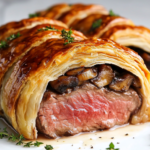
Perfect Beef Wellington Recipe: Tips, Techniques & Wine Pairings
Ingredients
- 1 center-cut beef tenderloin (approximately 2 pounds)
- Salt and freshly ground black pepper
- 2 tablespoons olive oil
- 2 tablespoons Dijon mustard
- 1 pound mushrooms (such as cremini or button), finely chopped
- 2 tablespoons unsalted butter
- 2 cloves garlic, minced
- 2 tablespoons fresh thyme leaves, chopped
- 8 thin slices of prosciutto
- 1 sheet puff pastry, thawed
- 1 egg, beaten
Instructions
- Prepare the Beef:
-
- Season the beef tenderloin generously with salt and freshly ground black pepper.
- In a large skillet, heat the olive oil over high heat. Sear the beef on all sides until browned, about 2-3 minutes per side.
- Remove from heat and brush the tenderloin with Dijon mustard while it’s still warm. Set aside to cool.
- Make the Mushroom Duxelles:
- In the same skillet, melt the butter over medium heat. Add the finely chopped mushrooms, minced garlic, and chopped thyme leaves.
- Cook until the mixture becomes a thick paste and all moisture has evaporated, approximately 10-15 minutes. Season with salt and pepper to taste. Let it cool completely.
- Assemble the Wellington:
- Lay a large piece of plastic wrap on a flat surface. Arrange the prosciutto slices on the plastic wrap, slightly overlapping, to form a rectangle large enough to envelop the beef.
- Spread the cooled mushroom duxelles evenly over the prosciutto layer.
- Place the seared beef tenderloin at the edge of the prosciutto-mushroom layer. Using the plastic wrap, carefully roll the prosciutto and mushroom mixture around the beef, forming a tight log. Twist the ends of the plastic wrap to secure and refrigerate for 15-20 minutes to firm up.
- Wrap in Puff Pastry:
- Preheat your oven to 400°F (200°C).
- On a lightly floured surface, roll out the puff pastry sheet into a rectangle large enough to encase the beef.
- Remove the beef from the plastic wrap and place it in the center of the puff pastry. Brush the edges of the pastry with the beaten egg.
- Fold the pastry over the beef, sealing the edges to form a tight package. Trim any excess pastry to avoid a thick crust.
- Place the wrapped beef seam-side down on a baking sheet lined with parchment paper. Brush the entire surface with the remaining beaten egg.
- Using a sharp knife, score the top of the pastry with a decorative pattern, being careful not to cut through to the beef.
- Bake:
- Bake in the preheated oven for 25-30 minutes, or until the pastry is golden brown and the internal temperature of the beef reaches 125°F (52°C) for medium-rare.
- Remove from the oven and let it rest for 10 minutes before slicing.

